 Week 17
Week 17
This week we turned to African-American cinematic representations of the city, from blaxploitation and the LA Rebellion group up to the New Jack Cinema and Boyz N the Hood (Singleton 1991). We were guided by Paula J Massood’s argument in Black City Cinema: African American Urban Experiences in Film that:
In the 1960s and 1970s, the American terrifying other was a generalized inner-city ghetto; in the 1990s, it became the young black man. (166)
Last week, we ended with Taxi Driver’s vision of an infernal Manhattan populated by a profoundly fallen humanity (Scorsese is nothing if not a Catholic director). It is an overtly stylised world, often seen through the windscreen of the vehicle which lends Travis mobility while separating him from the world outside. Typically, blaxploitation has a rather different sense of the city and explores it through different aesthetic choices. These points came up in our discussion of the opening sequence of Shaft (Parks 1971):
- daylight shooting
- long shots (and some long takes) using zoom lenses on frequently uncontrolled locations
- concealed – or apparently concealed – cameras so as to not draw the attention of passersby unaware that they are being filmed
- the city is shabby, run-down, collapsing, but also lively – and there is an everyday rather than demonic quality to the hustling
- Shaft (Richard Roundtree) moves through the crowded streets with a confidence that Travis Bickle lacked, untraumatised it seems by his experience of being in the world, mixing freely with others both black and white as if by his sheer presence he can command a world without racism
- different kind of soundtrack, and different relationship between soundtrack and image
Manthia Diawara argues that
space is related to power and powerlessness … those who occupy the center of the screen are usually more powerful than those situated in the background or completely absent from the screen. (qtd in Massood 173)
The opening of Shaft also points to this key factor in blaxploitation – for the first time since the threadbare and now mostly lost race movies of the 1920s and 1930s, large numbers of African-Americans (not just Sidney Poitier or Harry Belafonte, etc) got to occupy centre (and sometimes pretty much the entire) screen of a significant number of movies, as well as working in numbers behind the scenes. Richard Roundtree strutting easily through Manhattan to the sound of Isaac Hayes was and remains so utterly cool that we can perhaps still get some sense, 45 years later and an ocean away, of how important that moment must have been (even if we might be even more inclined now to question the gender politics and Shaft’s tendency to extract himself from the African-American community).
According to Thomas Doherty’s Teenagers and Teenpics: The Juvenilization of American Cinema in the 1950s, the ‘exploitation’ in ‘exploitation films’ refers to
1) the way in which a film was advertised and marketed to entice an audience into the theatre
2) the way in which the film endeared itself to its audience – content
3) and finally as a particular kind of film
This kind of “exploitation” became a cohesive production strategy with three elements:
1) controversial/bizarre/timely subject matter amenable to promotion
2) a substandard budget
3) a teenage audience
i.e., triply exploitative – exploiting sensational events for story value, their public notoriety for publicity value, and a teenage audience for box office value
This is also pretty much the sense in which the ‘xploitation’ in ‘blaxploitation’ is intended.
In the early 1970s, African Americans constitute 25-40% of Hollywood’s US audience. Following the success of Cotton Comes to Harlem (Davis 1970), Sweet Sweetback’s Baadasssss Song (Van Peebles 1971) and Shaft (Parks 1971), a low- and medium-budget production cycle helped to restore Hollywood profitability, but was then abandoned with the emergence of blockbuster cinema – Jaws (Spielberg 1975), Star Wars (Lucas 1977), etc – and of different modes of distribution and exhibition, a process aided by the closure and/or grindhousing and/or pornification of downtown cinemas and an increase in suburban cinemas.
Ed Guerrero argues in Framing Blackness: The African American Image in Film that blaxploitation was part of a larger ‘black film boom’ that saw ‘ninety-one productions’ in 1971-73, ‘of which forty-seven can be considered models of the Blaxploitation formula’ (95) – a fomula that .
usually consisted of a pimp, gangster, or their baleful female counterparts, violently acting out a revenge or retribution motif against corrupt whites in the romanticized confines of the ghetto or inner city. These elements were fortified with liberal doses of gratuitous sex and drugs and the representation of whites as the very inscription of evil. And all this was rendered in the alluring visuals and aggrandized sartorial fashions of the black underworld and to the accompaniment of black musical scores that were usually of better quality than the films they energized. (94)
Blaxploitation had African American critics of this sort from the outset. The term was coined by Junius Griffin, the head of the NAACP’s Beverley Hills-Hollywood branch, when he was quoted in The Hollywood Reporter decrying such ‘black exploitation films’ as Super Fly (Parks Jr 1972). Within days, he resigned from his post and co-founded the Coalition against Blaxploitation (CAB), with the support of various of the more conservative civil rights organisations (e.g., CORE, SCLC). In ‘Black movie boom – good or bad?’ (The New York Times 17 December 1972), he argued that
If black movies do not contribute to building constructive, healthy images of black people and to fairly recording the black experience, we shall have lost our money and our souls [and] have contributed to our own cultural genocide by only offering our children the models of degradation, destruction and dope’ (D19)
Griffin was by no means representative of all African Americans. In the same The New York Times piece, Gordon Parks describes the audience’s response to a crowded 4am screening of his Shaft:
Everything was ‘right on!’ A new hero, black as coal, deadlier than Bogart and handsome as Gable, was doing the thing that everyone in that audience wanted to see done for so long. A black man was winning. (D3)
Parks says of the ‘so-called black intellectuals’ demanding an end to blaxploitation that:
it is curious that some black people, egged on by some whites, will use such destructive measures against black endeavors. … The most important thing to me is that young blacks can now … enter an industry that has been closed to them for so long. (D3).
In Isaac Julien’s documentary Baadasssss Cinema (2002), blaxploitation star and occasional director Fred Williamson criticises NAACP and CORE for coining the implicitly derogatory term, asking
Who was being exploited? All the black actors were getting paid. They had a job. They were going to work. The audience wasn’t being exploited. They were getting to see things on their screens they had longed for.
Blaxploitation star Gloria Hendry adds,
the organizations failed to understand that the community was really in need of their own heroes and black movies.
And The Black Panther newspaper devoted the entire 19 June 1971 issue to Huey P. Newton’s review of Sweet Sweetback’s Baadasssss Song, which concludes ‘We need to see it often and learn from it’ (in To Die for the People (San Francisco: City Lights,
2009) 148).
Many blaxploitation films have an original music soundtrack, including Earth, Wind & Fire on Sweetback Sweetback’s Baadasssss Song, Millie Jackson on Cleopatra Jones (Starrett 1973), James Brown on Black Caesar (Cohen 1973) and Edwin Starr on Hell up in Harlem (Cohen 1973). Sound itself is also often used in interesting ways – partly post-classical stylistic innovation, partly symptomatic of the films’ extremely low budgets which relied on shooting without sound and dubbing later. For example, the opening ten minutes of Super Fly (Parks Jr 1972) contains extended sequences of a couple of would-be muggers walking through New York streets, Super Fly driving through the streets, and then chasing one of the muggers through the streets, much of it to Curtis Mayfield’s soundtrack; there are several similar sequences later in the film, including on using split screen arrangements of still images. On one level, an economy-driven necessity, it becomes an aesthetics concerned with occupying the screen (and soundtrack) space, and key to an actualité-ish depiction of black urban life.
Blaxploitation was often immensely profitable across the budgetary scale, especially in terms of box-office to outlay ratios. MGM budgeted $1.2 million each for Cotton Comes to Harlem and Shaft; the former grossed over $8 million domestically, the latter over $10.8 million in its first year of distribution. Low-budget Cinerama Releasing Corporation spent $200,000 on The Mack (Campus 1973), which grossed over $3 million, and AIP spent $500,000 on Coffy (Hill 1973), which grossed $6 million. The independent Sweet Sweetback’s Baadasssss Song cost an estimated $500,000 and took $4.1 million on its initial domestic release, dislodging Love Story (Hiller 1971) from number one at the US box office, and eventually grossed $10-15 million.
The soundtracks were also often successful. The soundtrack albums for Shaft and Cleopatra Jones (Starrett 1973) sold hundreds of thousands of copies. Super Fly, the first entirely black-financed film to be released by a Hollywood Studio, and the first to employ an almost entirely Black and Puerto Rican crew (mostly drawn from Third World Cinema Corporation, a Harlem-based collective co-founded by Ossie Davis in 1971), had an estimated budget of $100,000 but took $6.4 million during its initial run, eventually grossing over $12 million. Controlled and released by his own publishing company and independent record label, Curtis Mayfield’s singles ‘Super Fly’ and ‘Freddie’s Dead’ sold over 1 million copies each; the soundtrack album sold 12 million copies, earning him over $5 million. (See Eithne Quinn, ‘“Tryin’ to get over”: Super Fly, black politics, and post-civil rights film enterprise’. Cinema Journal 49.2 (2010): 86-105.)
Next, we moved from East Coast to West, to take a look at the sequence in Sweet Sweetback’s Baadasssss Song after Sweetback beats the cops to death and goes on the run. Van Peebles’s stylisations are even more overt than those of Scorsese, layering images, saturating them in psychedlic hues, and cutting with the rhythm of the music, which itself often seems to be improvised in conjunction with the images. Los Angeles is a disjointed, ruptured wasteland, more or less devoid of humanity. It is low and close the ground in contrast to New York, and seems to stretch on forever. Others might escape by plane, but all Sweetback can do is run and run and run.
And then we moved from blaxploitation – a category in which Sweetback does not always seems to fit easily, despite its massive importance to the cycle – to the LA Rebellion group. This network of African-American filmmakers, who studied at UCLA from the late-1960s onwards, made films that set out to resist Hollywood – and blaxploitation – norms, embracing the influence of Italian neo-realism and other European art cinema, and of politicised and postcolonial Latin American and African filmmaking. They made experimental and documentary shorts, documentary features and, later, videos, but the easiest of their work to access is their fiction features, including: Charles Burnett’s Killer of Sheep (1978); Larry Clark’s Passing Through (1977); Julie Dash’s Daughters of the Dust (1991); Jamaa Fanaka’s Penitentiary (1979); Haile Gerima’s Bush Mama (1976) and Sankofa (1993); and Billy Woodberry’s Bless Their Little Hearts (1983).
We took a look at an early sequence from Killer of Sheep, in which African-American kids throw stones at each other and play in the wasteland between railroad tracks. While the landscape itself seems familiar from Sweetback, the grainy – but often beautiful – black-and-white photography (another intersection of budget and aesthetics) contrasts with Van Peebles’s restless (and desperate) innovations. It recalls, in different ways, a number of films we have already watched on the module (Bicycle Thieves, The Third Man, Passport to Pimlico, Cléo from 5 to 7, Ratcatcher).
The soundtrack is likewise naturalistic, just voices and sounds of the city, creating a rather different effect than blaxploitation’s commitment to cutting edge soul and funk (and to Bush Mama’s more experimental layering of fragmentary voices on its soundtrack).
The New Jack Cinema ran from roughly 1989-95. Its key filmmakers and films were
Spike Lee: She’s Gotta Have It (1986), School Daze (1988), Do the Right Thing (1989), Mo’ Better Blues (1990), Jungle Fever (1991), Malcolm X (1992), Crooklyn (1994), Clockers (1995), Girl 6 (1996), Get on the Bus (1996), He Got Game (1998), Bamboozled (2000)
Bill Duke: A Rage in Harlem (1991)
Matty Rich: Straight Out of Brooklyn (1991)
John Singleton: Boyz N the Hood (1991), Poetic Justice (1993), Higher Learning (1995), Rosewood (1997)
Mario Van Peebles: New Jack City (1991), Posse (1993), Panther (1995)
Leslie Harris: Just Another Girl on the IRT (1992)
Allen and Albert Hughes: Menace II Society (1993), Dead Presidents (1995), American Pimp (1999)
Ernest Dickerson: Juice (1992), Blind Faith (1998)
As with the more or less simultaneous New Queer Cinema, it had a strong focus on male experience, and made efforts to diversify representation without reiterating stereotypes or insisting on ‘positive’ images. Its primary focus on African American urban experience was influenced by blaxplotiation’s and the LA Rebellion’s use of actual locations, but was also intertwined with the emergence of hip-hop culture over the preceding decade and more. The New Jack Cinema often depicted gang life, violence, misogyny and drug use in negative terms, but frequently also succumbed to the spectacle such things offered. There were also strong elements of melodrama and liberal handwringing, and a championing of education and middle class lifestyle choices. Unlike Beverly Hills Cop (Brest 1984), New Jack movies tend not to take a single black protagonist out of his own community and relocate him in a white community – a strategy also deployed by many post-New Jack movies, such as Training Day (Fuqua 2001) – but instead builds a picture of an ethnically, culturally, linguistically and generationally diverse neighbourhood, with a history
It is important to bear in mind bell hooks’s comments on the historical, political, economic, cultural and social context of gangsta rap:
The sexist, misogynist, patriarchal ways of thinking and behaving that are glorified in gangsta rap are a reflection of the prevailing values in our society, values created and sustained by white supremacist capitalist patriarchy. (Outlaw Culture (London: Routledge, 1994): 116)
Like blaxploitation, the New Jack Cinema was often extremely profitable. She’s Gotta Have It was shot in 12 days for $175,000 and took over $7 million in the US alone. (It is relatively unusual in being woman-centred, but is problematically centred on a woman whose choice to have multiple sexual partners is repeatedly eroticised and spectacularised.) Do the Right Thing cost $6 million, and took $60 million in the US, with two Oscar nominations (best screenplay, supporting actor). Newspapers worried its ambivalent conclusion would lead to riots. Just Another Girl on the IRT was shot in 17 days for $100,000, took $500,000 at US box office (again relatively unusual, not only in that it focuses on female experience, but on teen female experience and was made by a woman). Like Boyz N the Hood, it ends in blood, but not a drive-by or gang-killing. Instead, it culminates in a long scene of protagonist Chantel’s (Ariyan A Johnson) agonising premature childbirth – she is in denial about and has concealed her unwanted pregnancy, and thus is completely unprepared. Boyz N the Hood cost $6 million, and took $60 million in the US alone; 23-year-old John Singleton was nominated for best director and best original screenplay Oscars.
We focused primarily on the kinds of spaces the film depicted and how they were shot. There is none of the excessive stylisation of Scorsese, no attempt to depict South Central as infernal. There is no attempt to depict the area as a crumbling ruin, as in the views of Manhattan in Shaft and Super Fly, or as an urban wasteland, as in Sweet Sweetback’s Baadasssss Song and Killer of Sheep. In fact, the ‘natural’ daytime light and often pastels palette imbues the hood with the sense of a potentially idyllic suburb of evenly spaced houses in a variety of styles, each set in a neat little garden. Unlike Fahrenheit 451 and despite the ubiquity of television, people still sit on their porches, chatting and whiling away the time. This is countered, to some extent, by the high walls around the backyards and fence around some front yards; by the invisible but nonetheless affectively tangible walls around neighbourhoods and the city; by the role of mass unemployment and limited future prospects in all that porch-sitting; by the eruptions of gang violence and police violence; by the junkie mother who cannot look after her children (even if everyone else in the neighbourhood watches out for them); and by the almost constant nocturnal sound of police helicopters patrolling the skies above.
While Sweetback can at least run past LAX (and run), Boyz begins with a stop sign (while a jet climbs into the sky behind it). Such entrapment – such limited mobility in a city built for cars – is central to the film.
(As, rather more problematically, is its focus on the need for fathers to raise sons as real men so as to end ghetto immiseration and violence, since this involves constantly blaming mothers – reiterating a strong current in the period’s far from progressive political discourse. This goes so far as to undermine its own advocacy of such middle class values as education, responsibility and property ownership by finding fault with aspirational black women.)
Week 19
Core critical reading: Massood, Paula J. Black City Cinema: African American Urban Experiences in Film. Philadelphia: Temple University Press, 2003. 145–74.
Recommended critical reading
AlSayyas, Nezar. Cinematic Urbanism: A History of the Modern from Reel to Real. London: Routledge, 2006. See chapter 8, ‘An Alternative Modernity: Race, Ethnicity and the Urban Experience.”
Bausch, Katharine. “Superflies into Superkillers: Black Masculinity in Film from Blaxploitation to New Black Realism.” Journal of Popular Culture 46.2 (2013): 257–76.
Dyson, Michael Eric. “Between Apocalypse and Redemption: John Singleton’s Boyz N the Hood.” Cultural Critique 21 (1991): 121–41.
Farred, Grant. “No Way Out of the Menaced Society: Loyalty within the Boundedness of Race.” Camera Obscura 12.2 (1995): 6–23.
Gormley, Paul. “The Affective City: Urban Black Bodies and Milieu in Menace II Society and Pulp Fiction.” Screening the City. Ed. Mark Shiel and Tony Fitzmaurice. London: Verso, 2003. 180–199.
Guerrero, Ed. Framing Blackness: The African American Image in Film. Philadelphia: Temple University Press, 1993.
Kennedy, Liam. Race and Urban Space in Contemporary American Culture. Edinburgh: Edinburgh University Press, 2000. Chapter 3, “Between Pathology and Redemption.”
Massood, Paula J. “City Space and City Times: Bakhtin’s Chronotope and Recent African-American Film.” Screening the City. Ed. Mark Shiel and Tony Fitzmaurice. London: Verso, 2003. 200–215.
Mennel, Barbara. Cities and Cinema. London: Routledge, 2008. See chapter 7, “Ghettos and Barrios.”
Mukherjee, Roopali. “The Ghetto Fabulous Aesthetic in Contemporary Black Culture: Class and Consumption in the Barbershop Films.” Cultural Studies 20.6 (2006): 599–629.
Tarr, Carrie. Reframing Difference: Beur and Banlieue Filmmaking in France. Manchester: Manchester University Press, 2012.
Watkins, Craig S. Representing: Hip Hop Culture and the Production of Black Cinema. Chicago: Chicago University Press, 1999.
Recommended reading
African-American, Latino/a and Chicano/a ghetto fiction can be traced back at least as far as Paul Laurence Dunbar’s *The Sport of the Gods (1902), Rudolph Fisher’s The Walls of Jericho (1928) and The Conjure-Man Dies (1932) and Richard Wright’s Native Son (1940), and more autobiographical work, such as Claude Brown’s Manchild in the Promised Land (1965), Iceberg Slim’s Pimp: The Story of My Life (1967) and Piri Thomas’s Down These Mean Streets (1967).
It also draws on the pulp crime fiction of Chester Himes (e.g., A Rage in Harlem (1957)) and Donald Goines (e.g., Dopefiend (1971)), on blaxploitation cinema, New Jack cinema and hip-hop culture.
Contemporary examples include Omar Tyree’s Flyy Girl (1993), Sapphire’s Push (1996), Sister Souljah’s The Coldest Winter Ever (1999), Nina Revoyr’s Southland (2003) and Gary Phillips’s The Jook (2010), and such autobiographical works as Luis J Rodriguez’s Always Running: La Vida Loca, Gang Days in L.A. (1993) and Sanyika Shakur’s Monster: The Autobiography of an L.A. Gang Member (1993).
Recommended viewing
Key blaxploitation films include Sweet Sweetback’s Baadasssss Song (Van Peebles 1971), Shaft (Parks 1971) and Superfly (Parks Jr 1972).
The LA Rebellion group’s more neo-realist depiction of black urban life can be seen in Killer of Sheep (Burnett 1978) and Bush Mama (Gerima 1979).
Key New Jack cinema films include Do the Right Thing (Lee 1989), Just Another Girl on the IRT (Harris 1992) and Menace II Society (Hughes brothers 1993).
Depictions of ghetto life have become a significant part of world cinema, including such films as La Haine (Kassovitz 1995), City of God (Meirelles and Lund 2002), Jerusalema: Gangster’s Paradise (Ziman 2008) and Attack the Block (Cornish 2011).
 In January 1977, some nine months into a disastrous shoot, Francis Ford Coppola hired Ballard to script-doctor a key sequence and to help fashion the satisfactory dénouement that had thus far eluded John Milius, George Lucas and Coppola himself. Ensconced in the Philippines, Ballard eventually declared the de Marias rubber plantation sequence beyond salvaging. He was delighted when problems with the sound recording meant it was cut from the film, and in 2001 declined an invitation to see it restored at the Cannes premier of Apocalypse Now Redux.
In January 1977, some nine months into a disastrous shoot, Francis Ford Coppola hired Ballard to script-doctor a key sequence and to help fashion the satisfactory dénouement that had thus far eluded John Milius, George Lucas and Coppola himself. Ensconced in the Philippines, Ballard eventually declared the de Marias rubber plantation sequence beyond salvaging. He was delighted when problems with the sound recording meant it was cut from the film, and in 2001 declined an invitation to see it restored at the Cannes premier of Apocalypse Now Redux.

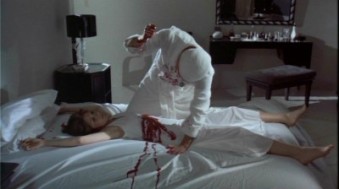 him uncontrollably violent. The medical staff set out to find him. Shortly after the tipping-point passes, Angela is found murdered, her skull crushed and her body repeatedly stabbed post-mortem.
him uncontrollably violent. The medical staff set out to find him. Shortly after the tipping-point passes, Angela is found murdered, her skull crushed and her body repeatedly stabbed post-mortem.

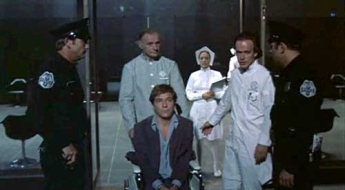 When Benson arrives at the hospital, Morris signs for him ‘as if he were receiving a package from United Parcel’ (8), a subjection to bureaucratic processes that resonates with the patient’s psychosis. McPherson later suggests that Benson has been turned into ‘a read-out device’ for the implanted computer, ‘as helpless to control the read-out as a TV screen is helpless to control the information presented on it’ (83; italics in original). The hospital computer refers to Benson as an ‘auxillary unit’ (120), while he describes himself as ‘an automobile in a complicated service station’ (125). Morris begrudges his pager, which keeps him perpetually networked into administrative systems, and at one point suddenly notices that computers monitor and predict LA traffic flows. Such ruminations are given a sense of inevitable – and detrimental – consequence through the linear determinism espoused by several characters and by the frequency with which futurological and computer projections are treated as inarguable: in 1967, McPherson surveyed the fields of ‘diagnostic conceptualization, surgical technology, and microelectronics’ and concluded that it would be possible to perform ‘an operation for ADL seizures in July of 1971’ (197), a prediction which proved too conservative by four months; and the positive progression cycle, in which Benson’s brain learns to trigger seizures, is plotted from just three points on a graph, predicting to within a couple of minutes when he will go into continuous stimulation. Consequently, when Morris is told about July 1969’s ‘Watershed Week’ – ‘when the information-handling capacity of all the computers in the world exceeded the information-handling capacity of all the human brains in the world’ – and that by 1975 computers will ‘lead human beings by fifty to one in terms of capacity’ (159-60), the novel succeeds in conveying a sense of menace. This is achieved by conflating a not unreasonable prediction of quantitative change with the implication that it must necessarily result in a threat to humanity – or at least to our human qualities (which consist entirely of small-town, middle-American values).
When Benson arrives at the hospital, Morris signs for him ‘as if he were receiving a package from United Parcel’ (8), a subjection to bureaucratic processes that resonates with the patient’s psychosis. McPherson later suggests that Benson has been turned into ‘a read-out device’ for the implanted computer, ‘as helpless to control the read-out as a TV screen is helpless to control the information presented on it’ (83; italics in original). The hospital computer refers to Benson as an ‘auxillary unit’ (120), while he describes himself as ‘an automobile in a complicated service station’ (125). Morris begrudges his pager, which keeps him perpetually networked into administrative systems, and at one point suddenly notices that computers monitor and predict LA traffic flows. Such ruminations are given a sense of inevitable – and detrimental – consequence through the linear determinism espoused by several characters and by the frequency with which futurological and computer projections are treated as inarguable: in 1967, McPherson surveyed the fields of ‘diagnostic conceptualization, surgical technology, and microelectronics’ and concluded that it would be possible to perform ‘an operation for ADL seizures in July of 1971’ (197), a prediction which proved too conservative by four months; and the positive progression cycle, in which Benson’s brain learns to trigger seizures, is plotted from just three points on a graph, predicting to within a couple of minutes when he will go into continuous stimulation. Consequently, when Morris is told about July 1969’s ‘Watershed Week’ – ‘when the information-handling capacity of all the computers in the world exceeded the information-handling capacity of all the human brains in the world’ – and that by 1975 computers will ‘lead human beings by fifty to one in terms of capacity’ (159-60), the novel succeeds in conveying a sense of menace. This is achieved by conflating a not unreasonable prediction of quantitative change with the implication that it must necessarily result in a threat to humanity – or at least to our human qualities (which consist entirely of small-town, middle-American values).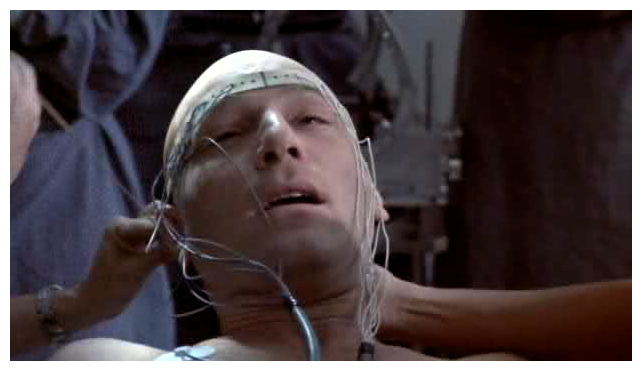 Curiously, though, Crichton also struggles at times to express a sense of the complex, non-linear determinism underpinning his trademark narrative about the failure of complex systems, best – if still rather clumsily – articulated through the chaos mathematics he invokes in Jurassic Park (1990). In The Terminal Man, it is most clearly developed through Gerhard’s computer programmes, called Saint George and Martha. Designed to interact with each other, they are capable of responding ‘with three emotional states – love, fear, and anger’ and of ‘produc[ing] three actions – approach, withdrawal, attack’ (99). Despite this system’s simplicity, it ‘produce[s] complex and unpredictable machine behavior’ (115). After running more than a hundred times, Saint George, ‘programmed for saintliness’, ‘is learning not be a saint around Martha’ (103), even threatening to kill her. This is presented as a value-neutral experiment, but the obvious gender stereotyping suggests that the dependence on initial conditions need not be that sensitive to produce this result. The implications of a later discussion, in which Gerhard and Ross contemplate the possibility that after twenty-four hours of stimulations Benson’s brain has become something radically different than the one on which they operated and thus beyond their capacity to predict, are likewise countered by the utter predictability of the plot.
Curiously, though, Crichton also struggles at times to express a sense of the complex, non-linear determinism underpinning his trademark narrative about the failure of complex systems, best – if still rather clumsily – articulated through the chaos mathematics he invokes in Jurassic Park (1990). In The Terminal Man, it is most clearly developed through Gerhard’s computer programmes, called Saint George and Martha. Designed to interact with each other, they are capable of responding ‘with three emotional states – love, fear, and anger’ and of ‘produc[ing] three actions – approach, withdrawal, attack’ (99). Despite this system’s simplicity, it ‘produce[s] complex and unpredictable machine behavior’ (115). After running more than a hundred times, Saint George, ‘programmed for saintliness’, ‘is learning not be a saint around Martha’ (103), even threatening to kill her. This is presented as a value-neutral experiment, but the obvious gender stereotyping suggests that the dependence on initial conditions need not be that sensitive to produce this result. The implications of a later discussion, in which Gerhard and Ross contemplate the possibility that after twenty-four hours of stimulations Benson’s brain has become something radically different than the one on which they operated and thus beyond their capacity to predict, are likewise countered by the utter predictability of the plot.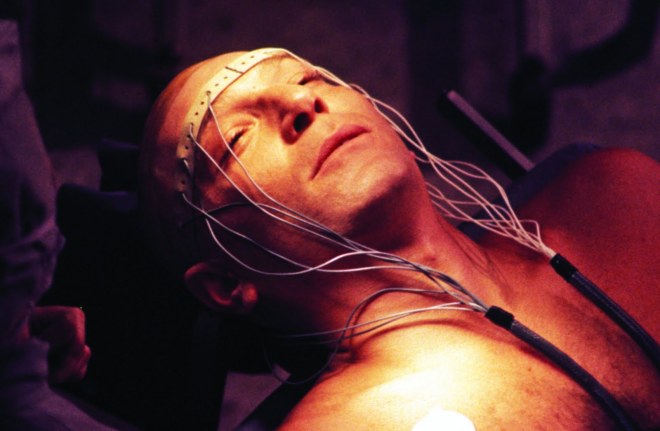 The film opens in pitch black night, the only light emanating from the cockpit of an insectile police helicopter facing the camera, the only noise that of its engines as it takes to the air; the helicopter will become an aggressively loud presence, signalling the powerlessness not merely of Benson (George Segal) to avoid it but of the audience in the face of the system it represents. The film cuts to a restaurant, in which doctors Ellis (Richard Dysart), McPherson (Donald Moffat) and Friedman (James Sikking) discuss Benson and ADL syndrome. Benson’s back-story is related, with impressive economy, through a series of photographs that the three men examine – Benson with his wife and daughter, Benson being arrested, the battered face of Benson’s wife – while planning the media coverage of the operation. To Hodges’ regret, he added this sequence to help allay studio concerns that ‘the film had no one to root for’ (personal email) rather than cutting
The film opens in pitch black night, the only light emanating from the cockpit of an insectile police helicopter facing the camera, the only noise that of its engines as it takes to the air; the helicopter will become an aggressively loud presence, signalling the powerlessness not merely of Benson (George Segal) to avoid it but of the audience in the face of the system it represents. The film cuts to a restaurant, in which doctors Ellis (Richard Dysart), McPherson (Donald Moffat) and Friedman (James Sikking) discuss Benson and ADL syndrome. Benson’s back-story is related, with impressive economy, through a series of photographs that the three men examine – Benson with his wife and daughter, Benson being arrested, the battered face of Benson’s wife – while planning the media coverage of the operation. To Hodges’ regret, he added this sequence to help allay studio concerns that ‘the film had no one to root for’ (personal email) rather than cutting 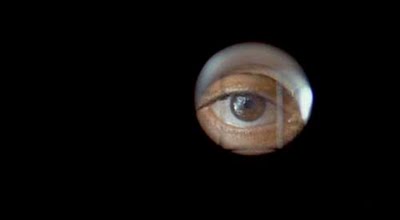 directly to the title sequence: a black screen with white credits, accompanied by Glenn Gould’s performance of Bach’s Goldberg Variation No. 25; footsteps approach in a corridor; a key chain rattles; there is a scraping sound, a peephole opens on the right of the screen and an eye peers through, looking out at the audience; the men in the corridor, functionaries of some institution, discuss Benson; the caption ‘tuesday’ appears, and the film cuts to Benson being delivered by the police to the hospital. Three more times during the film the screen goes to black, a peephole opens, and these anonymous, uneducated men – it is not clear if they are prison warders or asylum orderlies – discuss Benson. The film also ends with a version of this shot, in which one of the voices says, ‘They want you next’, to which the other responds ‘Quit kidding around’. These final words comically deflate the clichéd threat intoned by the first speaker; but beneath the end credits, the police helicopter descends through the night, coming full circle, yet instead of the deafening rotors there is silence, and then a cold wind howls. This hesitation – erasing then reinstating the film’s ominous implications – indicate Hodges’ wry amusement at the materials with which he is working and, simultaneously, a genuine sense that, despite their pulpiness, they can be utilised to critique contemporary social realities.
directly to the title sequence: a black screen with white credits, accompanied by Glenn Gould’s performance of Bach’s Goldberg Variation No. 25; footsteps approach in a corridor; a key chain rattles; there is a scraping sound, a peephole opens on the right of the screen and an eye peers through, looking out at the audience; the men in the corridor, functionaries of some institution, discuss Benson; the caption ‘tuesday’ appears, and the film cuts to Benson being delivered by the police to the hospital. Three more times during the film the screen goes to black, a peephole opens, and these anonymous, uneducated men – it is not clear if they are prison warders or asylum orderlies – discuss Benson. The film also ends with a version of this shot, in which one of the voices says, ‘They want you next’, to which the other responds ‘Quit kidding around’. These final words comically deflate the clichéd threat intoned by the first speaker; but beneath the end credits, the police helicopter descends through the night, coming full circle, yet instead of the deafening rotors there is silence, and then a cold wind howls. This hesitation – erasing then reinstating the film’s ominous implications – indicate Hodges’ wry amusement at the materials with which he is working and, simultaneously, a genuine sense that, despite their pulpiness, they can be utilised to critique contemporary social realities.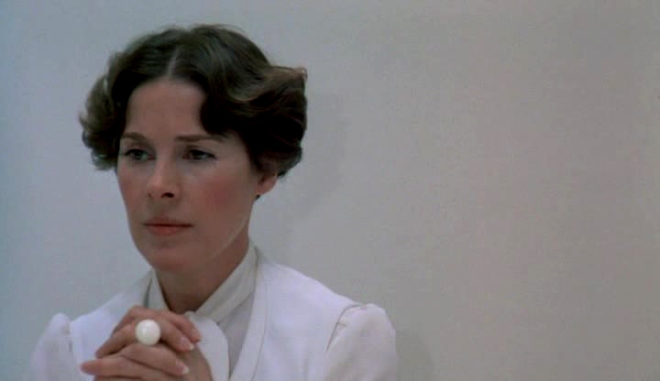 surgeons. While Crichton does acknowledge the sexism Ross faces, including incidents and passages of introspection, Hodges’ low-key spatialisation of patriarchal hegemony is far more effective. This spatialisation of gendered power is further emphasised during the sequence in which Ross’s discomfiture, when alone with Benson during the testing of his electrodes, is ignored by the male doctors observing them through one-way glass positioned high on the wall above them. The Foucauldian aspects of commonplace surveillance are even more clearly evinced during the lengthy surgical procedurals – articulated through an impeccable low-key precision, self-consciously devoid of the melodramatic imperatives shaping such sequences in Crichton’s E.R. (1994–2009) – as a crowd gathers around to observe the operation from above.
surgeons. While Crichton does acknowledge the sexism Ross faces, including incidents and passages of introspection, Hodges’ low-key spatialisation of patriarchal hegemony is far more effective. This spatialisation of gendered power is further emphasised during the sequence in which Ross’s discomfiture, when alone with Benson during the testing of his electrodes, is ignored by the male doctors observing them through one-way glass positioned high on the wall above them. The Foucauldian aspects of commonplace surveillance are even more clearly evinced during the lengthy surgical procedurals – articulated through an impeccable low-key precision, self-consciously devoid of the melodramatic imperatives shaping such sequences in Crichton’s E.R. (1994–2009) – as a crowd gathers around to observe the operation from above.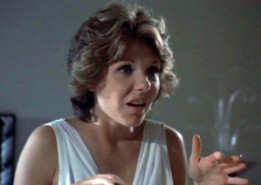 flirt with Angela (Jill Clayburgh)) seem to bemuse the other characters. Retrospectively, George Segal seems an unlikely Benson. Despite a successful career as a dramatic actor on stage, television and film, by the early 1970s he was focusing on the kind of comedy roles with which he has subsequently become most closely associated. By effectively casting him against type, Hodges produces a soft-spoken, genial everyman who is overtaken by external forces (the pre-credits material is, indeed, a misstep, giving Benson too much specificity, and counteracting the effectiveness of a later scene in which a recording of his litany of suburban lifestyle elements and possessions plays on multiple diegetic screens). He is particularly effective when his actions – stabbing Angela, attacking the robot on which he had been working – become mechanical, taking control of his body.
flirt with Angela (Jill Clayburgh)) seem to bemuse the other characters. Retrospectively, George Segal seems an unlikely Benson. Despite a successful career as a dramatic actor on stage, television and film, by the early 1970s he was focusing on the kind of comedy roles with which he has subsequently become most closely associated. By effectively casting him against type, Hodges produces a soft-spoken, genial everyman who is overtaken by external forces (the pre-credits material is, indeed, a misstep, giving Benson too much specificity, and counteracting the effectiveness of a later scene in which a recording of his litany of suburban lifestyle elements and possessions plays on multiple diegetic screens). He is particularly effective when his actions – stabbing Angela, attacking the robot on which he had been working – become mechanical, taking control of his body.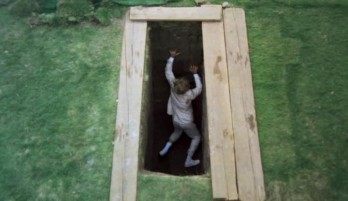 Finally, there is the revised ending of the story. Rather than seeing off Benson’s attack with her microwave, Ross, fearing he might attack her, holds out a knife towards him. In a moment of lucidity between stimulations, he walks onto the blade. Instead of launching an assault on the hospital computer, Benson then heads to a cemetery and descends into an open grave. The police close in and while Ross struggles to reach her patient, the police helicopter appears once more, bearing the sniper who will shoot Benson. People rush forward, and from the bottom of the grave we see them forced back by police whose vizored helmets recall not only those worn by the surgeons while they operated on Benson but also the brutally anonymous robot police of THX 1138 (Lucas 1971).
Finally, there is the revised ending of the story. Rather than seeing off Benson’s attack with her microwave, Ross, fearing he might attack her, holds out a knife towards him. In a moment of lucidity between stimulations, he walks onto the blade. Instead of launching an assault on the hospital computer, Benson then heads to a cemetery and descends into an open grave. The police close in and while Ross struggles to reach her patient, the police helicopter appears once more, bearing the sniper who will shoot Benson. People rush forward, and from the bottom of the grave we see them forced back by police whose vizored helmets recall not only those worn by the surgeons while they operated on Benson but also the brutally anonymous robot police of THX 1138 (Lucas 1971).



 The sequence ends with the revelation of the subterranean mall future, hints of mid-twentieth-century architecture’s International Style evident in buildings with set-back bases and non-supporting exterior walls. But before we get to the mall, there is a glimpse of a radiating landscape in the distance – of a Garden City.
The sequence ends with the revelation of the subterranean mall future, hints of mid-twentieth-century architecture’s International Style evident in buildings with set-back bases and non-supporting exterior walls. But before we get to the mall, there is a glimpse of a radiating landscape in the distance – of a Garden City. country’, or the Garden City. The idea was to build new towns from scratch that avoided urban poverty and squalor – overcrowding, poor drainage and ventilation, pollution, disease, lack of access to the natural world – by combining the pleasures/benefits of the country (nature, fresh air, low rent) with those of the city (opportunity, entertainment, good wages). The Garden Cities would be of limited size, preplanned, and owned by trustees on the behalf of the tenants – and thus also work to undermine private ownership and landlordism.
country’, or the Garden City. The idea was to build new towns from scratch that avoided urban poverty and squalor – overcrowding, poor drainage and ventilation, pollution, disease, lack of access to the natural world – by combining the pleasures/benefits of the country (nature, fresh air, low rent) with those of the city (opportunity, entertainment, good wages). The Garden Cities would be of limited size, preplanned, and owned by trustees on the behalf of the tenants – and thus also work to undermine private ownership and landlordism. This week we continued our exploration of the US postwar suburbs (
This week we continued our exploration of the US postwar suburbs (













